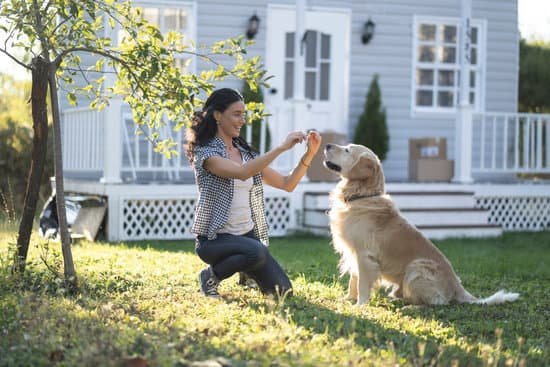What age can dogs be crate trained? Crate training is a valuable tool for dog owners, but knowing the right age to start this process is crucial. In this article, we will delve into the purpose of crate training for dogs, explore its benefits, and understand the right age to begin this training. We will also discuss the importance of patience and consistency in this process and provide helpful tips for successfully crate training your dog at any age.
Crate training serves multiple purposes for both dogs and their owners. It provides a safe and secure space for the dog, helps in housebreaking, and can aid in managing behavior issues such as separation anxiety. Understanding these reasons behind crate training is essential in determining when to start this process with your furry companion.
In addition to understanding the purpose of crate training, it’s important to recognize the various benefits it offers for dogs. From providing a sense of security to aiding in travel and vet visits, crate training can have positive impacts on a dog’s overall well-being. With the right approach, crate training can be an effective and beneficial experience for both you and your dog.
Benefits of Crate Training for Dogs
Crate training for dogs has numerous benefits that can positively impact both the pet and its owner. By understanding these benefits, dog owners can gain a deeper appreciation for the process and be more motivated to persevere through any initial challenges. Here are some of the key benefits of crate training for dogs:
- Security and Comfort: The crate can become a safe and secure space where the dog feels comfortable and relaxed, especially during times of stress or when they need time alone.
- Aid in House Training: Crate training can help with housebreaking as dogs are naturally inclined to avoid soiling their living area. This encourages them to hold their bladder and learn to wait until they are let outside.
- Preventing Destructive Behaviors: When properly introduced to a crate, dogs can learn to see it as their own space, reducing the likelihood of destructive behaviors from anxiety or boredom.
In addition to these benefits, crate training also provides convenience for dog owners by giving them peace of mind when leaving their pets at home or traveling. It also serves as a helpful tool for managing a dog’s behavior in various situations, such as visits to the veterinarian or when guests come over. Understanding these positive impacts emphasizes the importance of introducing crate training at the right age to maximize its effectiveness in a dog’s life.
Understanding the Right Age
Crate training is an essential part of raising a well-behaved and disciplined dog. However, many pet owners wonder at what age can dogs be crate trained and why it is important to consider the appropriate age for this training. Crate training is not just about confinement; it also helps in housebreaking, preventing destructive behavior, and providing a safe space for your furry friend.
What Age Can Dogs Be Crate Trained
The ideal age to start crate training your dog is between 8-12 weeks old. At this stage, puppies are still learning and are highly adaptable to new routines. This is the perfect time to introduce them to the concept of a crate as their den or safe haven.
Why It’s Important
Starting crate training at a young age helps puppies associate the crate with positive experiences, making it easier for them to adjust and feel comfortable inside it as they grow older. Crate training also assists in preventing separation anxiety and promoting good behavior when left alone at home.
Before starting crate training, it’s important to ensure that your dog has had all necessary vaccinations and has been cleared by a veterinarian for any health issues. Additionally, always make sure that the crate is spacious enough for them to stand up, turn around, and lie down comfortably. With consistency and patience, dogs of any age can be successfully crate trained.
The Importance of Patience and Consistency in Crate Training
Crate training is an essential part of raising a well-behaved and disciplined dog. It provides a safe and comfortable space for your furry friend, especially when you are not around to supervise them. However, crate training requires patience and consistency in order to be successful.
One of the most common questions that dog owners have is what age can dogs be crate trained. The truth is, dogs can be crate trained at any age, from puppies to adult dogs. The key is to understand that older dogs may take longer to adjust to the crate compared to puppies. It’s important to consider the individual temperament and history of each dog when starting crate training.
Patience is crucial when it comes to crate training. Some dogs may readily accept being in a crate, while others may need more time to get used to it. It’s important not to rush the process and allow your dog to become familiar with the crate at their own pace. Consistency is also key – use the same commands and routines when introducing your dog to the crate, and always reward good behavior.
It’s essential for dog owners to understand that every dog is different, and there is no one-size-fits-all approach when it comes to crate training. What works for one dog may not work for another, so it’s important to be patient and consistent in order to successfully crate train your furry companion.
| Age | Crate Training |
|---|---|
| Puppies | Puppies can start being introduced to a crate as early as 8-10 weeks old |
| Adult Dogs | Adult dogs can also be crate trained but may take longer than puppies due their established habits and behaviors |
Tips for Successfully Crate Training Your Dog at Any Age
When it comes to crate training your dog, it’s important to understand that it’s never too late to start. Whether you have a puppy or an adult dog, crate training can be successful at any age. However, the approach may differ depending on the age and previous experiences of your furry friend.
For puppies, crate training can begin as early as 8-12 weeks old. At this age, they are more receptive to new experiences and are still learning about their environment. It’s important to introduce the crate in a positive manner, using treats and toys to create a sense of comfort and security. Making the crate a positive space will help with both potty training and preventing destructive behavior when you’re not around.
For adult dogs, crate training may take a bit more time and patience, especially if they have had negative experiences with crates in the past. The key is to make the crate a place of safety and relaxation rather than punishment. Start by leaving the door open and allowing your dog to explore the crate at their own pace. You can also use treats and positive reinforcement to create a positive association with the crate.
It’s important to remember that every dog is different, so the timeline for successful crate training can vary. Some dogs may take to it quickly while others may need more time and encouragement. The key is patience and consistency in your approach, regardless of what age your dog is when you start crate training them.
| Age | Begin Crate Training |
|---|---|
| Puppies (8-12 weeks) | As early as 8-12 weeks old |
| Adult Dogs | At any age with patience and consistency |
Common Mistakes to Avoid When Crate Training Your Dog
When crate training your dog, it’s important to be aware of common mistakes that could hinder the process and cause unnecessary stress for both you and your pet. Avoiding these mistakes can help make the crate training experience more positive and effective for your furry friend.
Using the Crate as Punishment
One of the most common mistakes dog owners make when crate training their pets is using the crate as a form of punishment. It’s important to remember that the crate should be a safe and comfortable space for your dog, not a place where they are sent when they misbehave. Using the crate as punishment can create negative associations with the crate, making it more difficult for your dog to feel comfortable and at ease inside.
Leaving Your Dog in the Crate for Extended Periods
Another mistake to avoid is leaving your dog in the crate for long periods of time. While crate training is beneficial for teaching your dog boundaries and providing them with a safe space, it’s important to remember that they should not be confined to the crate for extended periods. Doing so can lead to anxiety, restlessness, and even physical discomfort for your pet.
Not Gradually Introducing Your Dog to the Crate
Properly introducing your dog to the crate is crucial for successful crate training. Some owners make the mistake of simply putting their dog into the crate without any prior introduction or acclimatization. This can cause distress and fear in your pet, making it more challenging to get them comfortable with being inside the crate. Gradually introducing your dog to the crate and associating positive experiences with it can help alleviate any reservations or anxieties they may have about being confined.
By being mindful of these common mistakes, you can ensure a smoother and more positive experience when crate training your dog at any age. Consistency, patience, and positive reinforcement are key elements in successfully acclimating your furry friend to their new living space.
Addressing Separation Anxiety and Crate Training
Separation anxiety can be a common issue for dogs when it comes to crate training. This is especially true for older dogs who may have formed strong attachments and routines with their owners. It is important to understand that crate training should not be used as a punishment, and it is crucial to address any separation anxiety your dog may experience during the training process.
One of the key strategies for addressing separation anxiety during crate training is to gradually acclimate your dog to spending time in the crate alone. Start by leaving the room for short periods of time while your dog is in the crate, and gradually increase the duration as your dog becomes more comfortable. It’s essential to make these separations positive experiences by providing treats, toys, or a comfort object for your dog to enjoy while in the crate.
Additionally, it’s important to create positive associations with the crate itself. You can do this by feeding your dog his meals inside the crate or placing some of his favorite toys or blankets inside. By making the crate a comfortable and enjoyable space for your dog, you can help alleviate any anxiety he may feel about being confined.
Consistency and patience are key when addressing separation anxiety during crate training. It’s important not to rush the process and to remember that every dog will progress at their own pace. With dedication and positive reinforcement, you can help your dog overcome separation anxiety and become comfortable with crate training at any age.
Gradually Introducing Your Dog to the Crate
When it comes to crate training your dog, the process should be gradual and positive to ensure success. Here is a step-by-step guide on how to introduce your dog to the crate:
1. Choose the right crate: First and foremost, it’s essential to select a crate that is appropriate for your dog’s size. The crate should be large enough for your dog to stand up, turn around, and lie down comfortably.
2. Make the crate inviting: You want your dog to associate the crate with positive experiences, so make it cozy and inviting. Place comfortable bedding inside and consider adding some of your dog’s favorite toys or a chew bone.
3. Introduce the crate slowly: Start by leaving the crate door open and allowing your dog to explore it at their own pace. You can encourage them with treats or praise when they enter the crate voluntarily.
4. Feeding in the crate: Once your dog seems comfortable being near the crate, start feeding them their meals near the crate. Gradually move the food bowl closer to the inside of the crate over several days until they are comfortable eating inside it.
5. Closing the door: Once your dog is entering and exiting the crate willingly, you can start closing the door for short periods while they eat or relax inside. Gradually increase the amount of time with the door closed as long as your dog remains calm and relaxed.
6. Alone time in the crate: After successfully closing the door with no signs of distress from your dog, you can start leaving them alone in their crate for short periods while you are at home. This will help prepare them for longer periods of alone time when necessary.
By following these steps and being patient with your dog, you can gradually introduce them to their new “den” in a positive way that sets them up for successful crate training at any age.
Conclusion
In conclusion, crate training can be an incredibly beneficial process for dogs when done correctly. It not only provides a safe and secure space for your furry friend but also helps in housebreaking, preventing destructive behavior, and easing separation anxiety.
As for the question of what age can dogs be crate trained, the answer lies in understanding the individual needs and behaviors of your dog. While some puppies can start crate training as early as 8-10 weeks old, older dogs can also learn to love their crates with patience and consistency.
It’s important to remember that patience and consistency are key when it comes to crate training. Rushing the process or forcing your dog into the crate can lead to negative associations, making the training even more challenging. Additionally, avoiding common mistakes such as using the crate as a form of punishment or leaving your dog crated for extended periods without breaks is crucial for successful crate training.
Ultimately, successfully crate training your dog at any age requires a gradual approach and positive reinforcement. By gradually introducing your dog to the crate, using treats and praise to create positive associations, you can help them see their crate as a safe and comfortable space. And in the long run, this will not only benefit your dog but also provide you with peace of mind knowing they have their own secure haven within your home.
Frequently Asked Questions
At What Age Can You Crate Train a Puppy?
You can start crate training a puppy as early as 8-10 weeks old. This is the age when they can start to control their bladder and hold it for short periods.
How Quickly Can You Crate Train a Dog?
The time it takes to crate train a dog can vary depending on the dog’s age, temperament, and past experiences with crates. Some dogs may take only a few days to adjust to being in a crate, while others may take weeks or even months.
Should I Put My 8 Week Old Puppy in a Crate at Night?
It is generally recommended to put an 8-week-old puppy in a crate at night. Crates provide a safe and secure environment for puppies, and it can also help with potty training by teaching them to hold it until they are taken outside.

Welcome to the blog! I am a professional dog trainer and have been working with dogs for many years. In this blog, I will be discussing various topics related to dog training, including tips, tricks, and advice. I hope you find this information helpful and informative. Thanks for reading!





